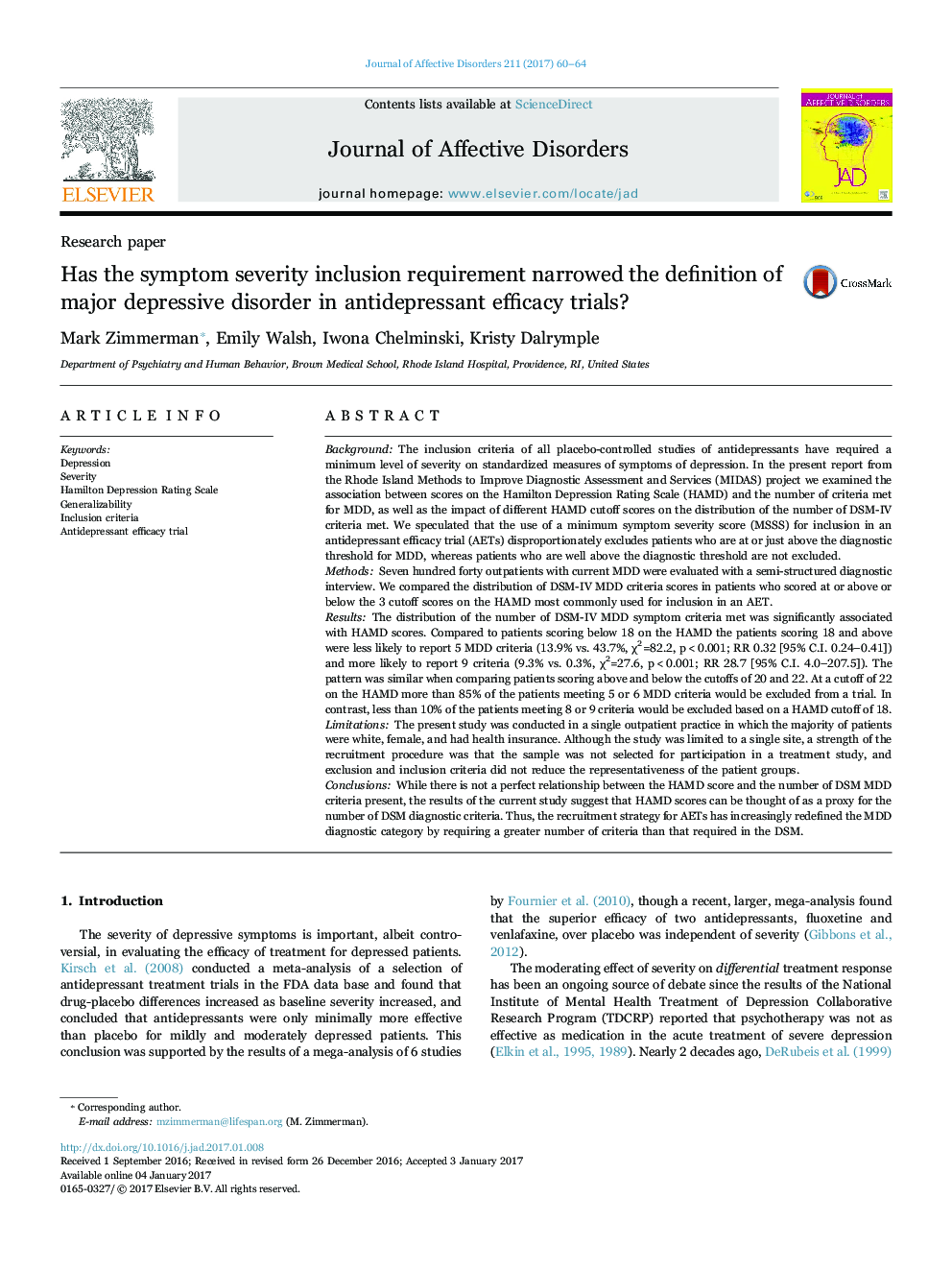| کد مقاله | کد نشریه | سال انتشار | مقاله انگلیسی | نسخه تمام متن |
|---|---|---|---|---|
| 5721905 | 1608114 | 2017 | 5 صفحه PDF | دانلود رایگان |
- Placebo-controlled studies of antidepressants require a minimum level of severity on standardized measures such as the HAMD.
- The number of DSM-5 MDD symptom criteria met is significantly associated with HAMD scores.
- Thus, placebo-controlled studies of antidepressants require more DSM-IV/DSM-5 symptom criteria than are required for the diagnosis.
BackgroundThe inclusion criteria of all placebo-controlled studies of antidepressants have required a minimum level of severity on standardized measures of symptoms of depression. In the present report from the Rhode Island Methods to Improve Diagnostic Assessment and Services (MIDAS) project we examined the association between scores on the Hamilton Depression Rating Scale (HAMD) and the number of criteria met for MDD, as well as the impact of different HAMD cutoff scores on the distribution of the number of DSM-IV criteria met. We speculated that the use of a minimum symptom severity score (MSSS) for inclusion in an antidepressant efficacy trial (AETs) disproportionately excludes patients who are at or just above the diagnostic threshold for MDD, whereas patients who are well above the diagnostic threshold are not excluded.MethodsSeven hundred forty outpatients with current MDD were evaluated with a semi-structured diagnostic interview. We compared the distribution of DSM-IV MDD criteria scores in patients who scored at or above or below the 3 cutoff scores on the HAMD most commonly used for inclusion in an AET.ResultsThe distribution of the number of DSM-IV MDD symptom criteria met was significantly associated with HAMD scores. Compared to patients scoring below 18 on the HAMD the patients scoring 18 and above were less likely to report 5 MDD criteria (13.9% vs. 43.7%, Ï2=82.2, p<0.001; RR 0.32 [95% C.I. 0.24-0.41]) and more likely to report 9 criteria (9.3% vs. 0.3%, Ï2=27.6, p<0.001; RR 28.7 [95% C.I. 4.0-207.5]). The pattern was similar when comparing patients scoring above and below the cutoffs of 20 and 22. At a cutoff of 22 on the HAMD more than 85% of the patients meeting 5 or 6 MDD criteria would be excluded from a trial. In contrast, less than 10% of the patients meeting 8 or 9 criteria would be excluded based on a HAMD cutoff of 18.LimitationsThe present study was conducted in a single outpatient practice in which the majority of patients were white, female, and had health insurance. Although the study was limited to a single site, a strength of the recruitment procedure was that the sample was not selected for participation in a treatment study, and exclusion and inclusion criteria did not reduce the representativeness of the patient groups.ConclusionsWhile there is not a perfect relationship between the HAMD score and the number of DSM MDD criteria present, the results of the current study suggest that HAMD scores can be thought of as a proxy for the number of DSM diagnostic criteria. Thus, the recruitment strategy for AETs has increasingly redefined the MDD diagnostic category by requiring a greater number of criteria than that required in the DSM.
Journal: Journal of Affective Disorders - Volume 211, 15 March 2017, Pages 60-64
